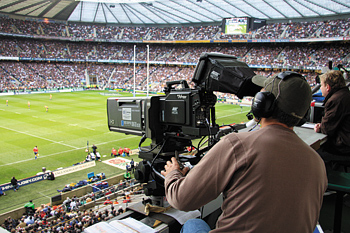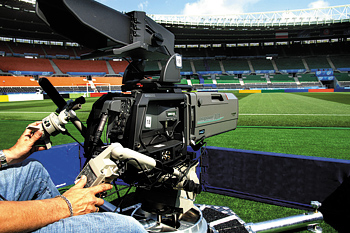Taking it Slo-Mo
SEATTLE
Video's original version of slow motion, developed by ABC President of Broadcast Operations and Engineering Julius Barnathan and his charges in the 1960s, utilized video captured at 30 frames-per-second, playing it back at a slower speed.
While revolutionary for its time, these slow motion replays paled in comparison to the long-established film technique of overcranking the camera to capture action at a higher than normal frame rate, then played back at film's normal frame rate. The film style replays provided a ballet-like look, compared to video's frame-slowing, strobing playback.

ARRI’s hi-motion high-speed, high definition camera was used at the Beijing Olympic Games. At least that was the difference before the coming of a new generation of true slow motion (TSM) cameras.
READY AND ABLE
The first TSM video cameras were used for industrial work, documenting events like crash tests. Video quality was a distant second in priority to raw frame speed, with low resolution and bad color (if there was any color at all). And there was a delay for processing before the video could be replayed.
When these early TSM video replays did make their way into sports broadcasts, the announcers often noted that what the viewers were seeing was so amazing it was OK if the picture was crummy. Video slow motion has come a long way. First, video quality of TSM replays is indistinguishable from the live action shots that make up the bulk of the telecast. And the slow motion video is available for replay immediately.
Makers of TSM cameras have diverged down two paths. Several traditional broadcast camera makers have developed high-definition TSM cameras capable of moderately increased frame rates, but that can also deliver a normal 30 fps output for live action coverage. Others have worked to bring high-quality HD video and instant playback capability to the high frame rate cameras.
Ikegami, Sony and Thomson Grass Valley are in the first group, providing high-definition TSM cameras that can image two and three-times normal speed into a video server for slow motion playback, but at the same time can also output 30 fps video to be switched into live game-action coverage.
"The ability to do three times super motion meets the need for quality motion analysis and adds immensely to the HD viewing experience," said Rob Willox, director, content creation group, Sony Electronics' Broadcast and Production Systems Division. Sony's portable HDC3300 is switchable between 1x, 2x and 3x acquisition.
Bart van Dijk, marketing manager for cameras at Thomson Grass Valley, pointed to the convenience and cost-effectiveness of using the same camera (and camera location and operator) for both slow motion and live coverage. "It is important for customers to use that camera for slow motion, and be able to switch the normal output into live-action coverage," Dijk said. Thomson Grass Valley's LDK 8300 is also a portable design, and switchable between 1x, 2x and 3x acquisition.
While Thomson Grass Valley and Sony's TSM offerings use CCD sensors, Ikegami has chosen CMOS for their TSM cameras. "Generally there is more flexibility to the CMOS sensors," said Alan Keil, vice president of engineering for Ikegami. Ikegami provides the HDK-79EC/HD portable design and the HDL-50EC/HD box design TSM cameras, capable of acquiring at both 1x and 2x.
As these cameras image video at higher frame rates, light becomes a factor in two ways. First, to acquire at higher frame rates, the actual acquisition time per frame is shorter, which translates into less light. Thus at 3x acquisition speed, there's 1/3 the exposure time. This can mean that in locations with marginal lighting for normal speed video acquisition, high-speed acquisition can be problematic.
"To overcome the issue, we improved the CCD's sensitivity so that it will not actually go down one-third," said Sony's Willox.
The second factor is the AC cycle of venue lighting. Where 1x (30 fps) and 2x (60 fps) acquisition generally includes the peak of the lighting system's AC cycle, one out of three frames during 3x (90 fps) acquisition will capture a valley in the AC cycle, which can cause flickering during playback.
"To compensate for this flicker, we implemented our AnyLight anti-flicker feature, a processing algorithm that compensates for the difference in the amount of lighting per frame," said Thomson Grass Valley's van Dijk.

Thomson Grass Valley’s LDK 8300 is switchable between 1x, 2x and 3x acquisition. Sony addressed this problem with "auto detect or area detection circuitry, which helps to compensate for this flicker," said Willox.
There's one more issue that Sony and Thomson Grass Valley have addressed with additional processing circuitry. Just picking every third frame for live-action coverage while a camera acquires at a 3x frame rate would result in an annoying high shutter speed effect that would not intercut with the regular cameras used for the remote. Both company's products use proprietary processes to combine the three frames into one.
OTHER APPROACHES
Companies like Vision Research, Inc. (VR) have headed down the other path of TSM cameras, raw high frame rate cameras. Their frame rate is so fast that, for initial image capture, cabling to a server is not an option.
"When you're capturing images at really high speed, you need an extremely fast storage device," said Rick Robinson, VR director of marketing. "So we use extremely fast RAM in the camera itself [for initial capture]." VR's Phantom V12.1 portable camera can acquire video at 6242 fps with full HD resolution. The single sensor V12.1 portable camera takes F-mount lenses, or with an optical adapter can use the PL mount lenses common to 2/3-inch cameras.
As soon as that capture is done, the images are immediately available for playback from the camera at whatever frame rate is desired. Robinson said triggering the video capture itself is usually done by the camera operator. Playback can be done by a slo-mo operator back in the remote truck.
At extremely high frame rates of which the V12 is capable, the amount of light available is important. "If you're outdoors in the sunlight, that's not going to be an issue," said Robinson. "But if you're in a stadium, it can limit the frame rate at which you can shoot."
VR has increased the camera's sensitivity through proprietary CMOS sensor technology, which allows them to control each pixel on the sensor itself. As to artificial lighting's AC cycle, large venues often have some of their lights on one cycle, others on another, which can mitigate the problem.
ARRI Media's Hi-Motion camera splits the difference between the two paths noted above. It can be used for live-action game coverage, or for high-speed capture of up to 600 fps, for 24x slow motion playback. A portable design with three 2/3-inch sensors, it takes the same lenses as normal remote truck cameras.
"Hi-Motion has been designed, from day one as a television camera," said Andy Hayford, ARRI digital high speed manager. For sports such as cricket and baseball, it tends to get used more for its regular speed capture capability. "In fast moving sports, such as soccer and rugby, it tends to only get used as a replay camera," he said.
As for the amount of stadium lighting necessary, Hayford said that in well-lit venues the Hi-Motion could be used at full 24x, though in marginally lit locations it may have to be slowed down.
Get the TV Tech Newsletter
The professional video industry's #1 source for news, trends and product and tech information. Sign up below.
